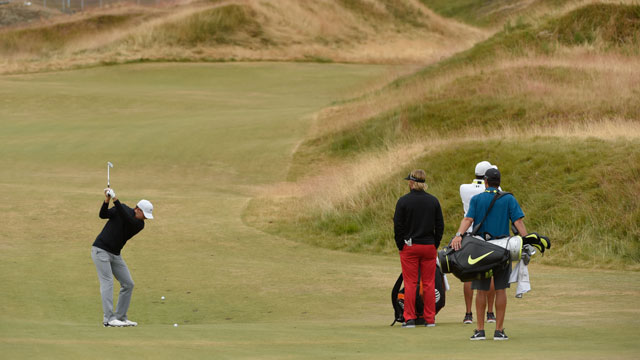NEWS
Figuring out how to play, and where to go, at Chambers Bay is challenge
By Doug Ferguson
Published on

UNIVERSITY PLACE, Wash. (AP) – Robert Streb walked off the third green at Chambers Bay, looked both directions and headed left down a dirt path toward Puget Sound.
Wrong way.
He walked back up the hill and stood in front of a large sign that showed a map of the course, arms crossed as he tried to figure out one of the many mysteries about this U.S. Open course. In this case, it was a simple question – where was No. 4?
Streb wasn't alone.
"It was early on in the course, I think around the third or fourth hole," Paul Casey said Monday. "My caddie walked the course the day before and knew the way. But I saw many caddies who were lost searching for the fourth tee."
There are more pertinent questions about Chambers Bay, the newest course in 45 years to host a U.S. Open. Never has a U.S. Open course featured so much elevation. One fairway is just over 100 yards wide. And it's so difficult to determine where the fairway ends and the green starts that the USGA has marked each green with white dots about a yard apart to outline the putting surface.
Morgan Hoffmann, one of 11 players who competed at Chambers Bay in 2010 for the U.S. Amateur, described it with words that could take on any meaning.
Interesting. Different.
About the only one he left out was exciting.
"Oh, it will be exciting, absolutely," Hoffmann said. "There's going to be shots you see on TV that they're going to replay and you're going to say, 'How did that happen?' Because you can't see anywhere near what the slopes are."
Monday was busier than usual for a U.S. Open as the courtship of Chambers Bay got started with the first official day of practice, and so was Tuesday.
Tiger Woods was among those who took a scouting trip within the past two weeks. He was first out on the back nine and plans to go nine holes a day. Jordan Spieth played Chambers Bay for one round in the U.S. Amateur (he shot 83), played it again when his caddie got married and spent the weekend getting reacquainted.
The reviews are mixed, which is not unusual for any U.S. Open.
Chambers Bay is not a links course. It just dresses up like one, especially with the fescue grass that gives the course a blend of brown and green, mixed with yellow wisps of fescue framing the rugged and expansive bunkers.
"There's plenty of danger out there," Paul Casey said. "Visually, it's fairly generous off the tee with what I've grown up with on links, if you're going to call this a links. You can have a lot of fear standing on the tee at links courses – Muirfield, Birkdale and the like.
"You know if you don't pipe it, you're going to be looking for a ball for a long time. Here, it's generous. The premium is put on the second shot and on the green. Where do you miss your second shot?"
Retief Goosen, a two-time U.S. Open champion, hit the front of the first green in front of the flag, which was the wrong spot. It took a slope to the left and rolled off the green. It rolled so far, in fact, that Goosen had to use a laser to figure out how hard he had to get back toward the flag.
The greens have so much contour that they look like oversized potato chips. Bubba Watson posted a video of him with his back to the hole, putting some 40 feet away from the cup up a ridge and watching it roll back and into the hole.
Streb, once he found his way to the fourth tee, proved to be a quick study. The flags on the green might as well been there for decoration. Streb stood in the fairway and gazed some 30 yards right of the green.
There were two TV towers on either side of a large grandstand. He settled on a USGA logo in the mesh bunting of the bleachers, the third one from the left, as his best line to get close to the hole.
"I think it's a fun golf course," Jimmy Walker said. "You have to be really careful hitting into the greens – where to hit and where not to hit. ... My first go-around, you see the pin and look at the book and it was hard to tell. I've still got some studying to do."
It can be deceptive in so many ways.
Walker recalled one par 4 in which he thought he could clear all the bunkers down the right side. His caddie, Andy Sanders, was telling him to go much farther left away from the trouble.
"Visually, I couldn't do it. It didn't look right," Walker said. "I went ahead and did it my way. And it was bad."
For the moment, Chambers Bay is so new and so different that it's more intriguing than aggravating. Then again, scores don't count until Thursday. Walker said he played in a group that produced plenty of birdies and decent scores.
And one aspect of the U.S. Open has changed.
"I don't know exactly what the mission statement is to find a U.S. Open course and how to set it up," two-time Open champion Lee Janzen said.
"But I would imagine that it would be to provide a challenging test so that the best players in the world are challenged, and hopefully bring out the best players for that week."
Copyright (2015) Associated Press. All rights reserved. This material may not be published, broadcast, rewritten, or redistributed. This article was written by Doug Ferguson from The Associated Press and was legally licensed through the NewsCred publisher network.
